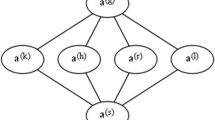Abstract
United States (US) policy makers often rely on economic indicators in order to determine citizens’ well-being. Authors of other research in the area of well-being have reported that well-being is a function of other factors beyond just income including health indicators such as physical and mental health, social interactions such as employment and productivity, and politics. Therefore, inclusion of these other factors would better capture variations in well-being. In this paper, well-being in each of the fifty states in the US is assessed using a mixed panel model approach (2009–2011) including typical economic and political measures. The findings from the empirical analysis reveal higher level of equality, as measured by the Gini coefficient, was the strongest indicator of well-being. Conversely, in states considered as politically conservative, an inverse relation was shown to exist between higher levels of state conservative politics and levels of average well-being by state. Finally, per capita income growth was difficult to measure as it related to well-being due to the fluctuations attributed to the recession of 2008. Therefore, state policies focused only on economic measures could not be verified whereas the income equality and/lower levels of income disparity would benefit the state population, as a whole, in terms of well-being.
Similar content being viewed by others
Notes
The author would like to thank a referee for this suggestion on using first differences in per capita income.
Taxes and tax rates were not statistically significant in any of the models and when removed, the parameters on the other independent variables did not change. Therefore, taxes were not included for the sake of brevity and clarity.
These states are: Alabama, Alaska, Georgia, Idaho, Kansas, Louisiana, Maine, Mississippi, Montana, Nebraska, North Carolina, South Carolina, Texas, and Wisconsin.
References
Allen, G. (2013). http://www.npr.org/2013/04/29/179762891/after-belt-tightening-some-states-are-back-in-the-black.
Andrulis, D. (1998). Access to care is the centerpiece in the elimination of socioeconomic disparities in health. Annals of Internal Medicine, 129(5), 412–416.
Anielski, M. (2008). The economics of happiness. Gabriola Island: New Society Publishing.
Associated Press. (2013). State leaders deal with consequences of rejecting Medicaid expansion in Obama health overhaul. http://articles.washingtonpost.com/2013-04-22/politics/38717fifty4_1_medicaid-expansion-alan-weil-tax-penalties.
Blanchflower, D., & Oswald, A. (2004). Well-being over time in Britain and the USA. Journal of Public Economics., 88, 1359–1386.
Center for Disease Control and Prevention. (2013). Well-being concepts. http://www.cdc.gov/hrqol/well-being.htm.
CNN. (2013). http://money.cnn.com/2013/09/25/news/economy/income-inequality.
Davis, K. (2009). Who pays? A distributional analysis of the tax systems in all 50 States (3rd ed.). Insitute of Taxation and Economic Policy.
Diener, E., & Selignman, M. E. P. (2004). Beyond money: Toward an economy of well-being. Psychological Science in the Public Interest, 5(1), 1–31.
Forbes. (2013). http://www.forbes.com/sites/christopherhelman/2013/01/09/the-worlds-happiest-and-saddest-countries-2/table.html.
Ferrer-i-Carbonell, A. (2005). Income and well-being: An empirical analysis of the comparison income effect. Journal of Public Economics, 89, 997–1019.
Gallup State of the States. (2012). http://www.gallup.com/poll/12fifty66/state-states.aspx.
Greene, W. (2010). http://pages.stern.nyu.edu/~wgreene/DiscreteChoice/Readings/Greene-Chapter-9.pdf.
Kibert, C., Monroe, M., & Peterson, A. (2012). Working toward sustainability: Ethnical decision making in a technological world. Hoboken, NJ: Wiley.
Mankiw, N. G. (2009). Principles of economics (6th ed.). Mason, OH: South-Western Cengage Leaning.
Mauer, R. (2013). While Alaska’s report on Medicaid is secret, information is available from other sources. http://www.adn.com/2013/10/26/3144208/while-alaskas-report-on-medicaid.html.
NBER. (2010). http://www.ritholtz.com/blog/2010/09/its-official-recession-ended-june-2009/.
Oishi, S., Schimmack, U., & Diener, E. (2012). Progressive taxation and the subjective well-being of nations. Psychological Science, 23(1), 186–192.
Oliff, P., Mai, P. C., Johnson, N. (2012). The impact of state incomes taxes on low-income families in 2011. Center on Budget and Policy Priorities http://www.cbpp.org/cms/?fa=view&id=3740.
Posner, R. (2003). Law, pragmatism, and democracy. Cambridge, MA: Harvard University Press.
Rawls, J. (1971). A theory of justice. Cambridge: Harvard University Press.
Sen, A. (1999). Commodities and capabilities. Oxford: Oxford University Press.
Stiglitz, J. (2013). The price of inequality. New York: W.W. Norton. http://taxfoundation.org/article_ns/state-individual-income-tax-rates-2000-2013.
Acknowledgments
The author would like to acknowledge with thanks the input from two anonymous referees and Professor Gary Ferrier. Any remaining errors are mine alone.
Author information
Authors and Affiliations
Corresponding author
Rights and permissions
About this article
Cite this article
Valdmanis, V.G. Factors Affecting Well-Being at the State Level in the United States. J Happiness Stud 16, 985–997 (2015). https://doi.org/10.1007/s10902-014-9545-0
Published:
Issue Date:
DOI: https://doi.org/10.1007/s10902-014-9545-0




